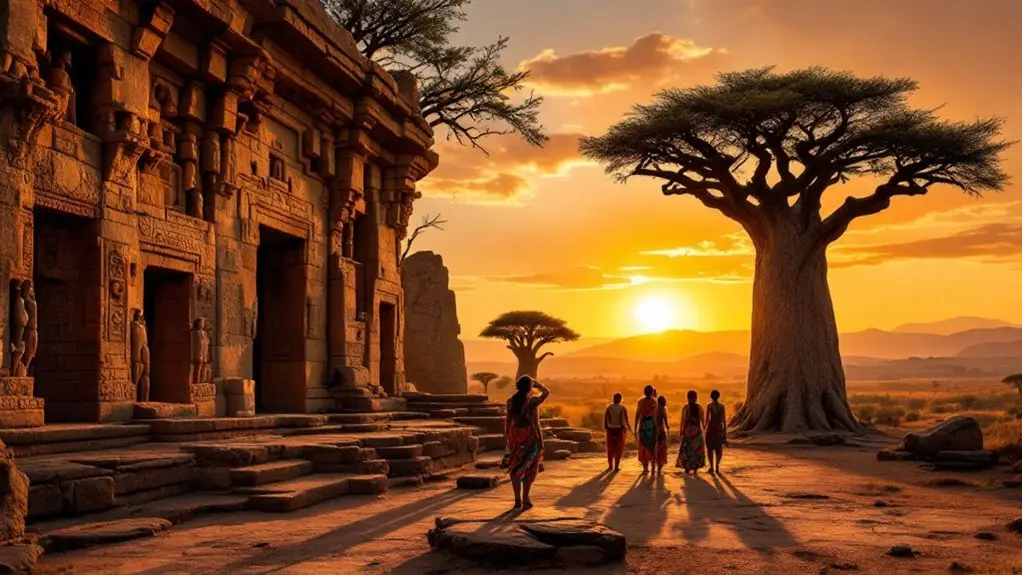You might be surprised to learn that Africa is home to some of the world's earliest and most advanced civilizations, each with its own unique contributions to human history. As you explore ancient sites like the pyramids of Meroe or the ruins of Great Zimbabwe, you'll uncover stories of innovation and resilience that shaped the continent. But what might really intrigue you are the intricate trade routes that not only connected these civilizations but also facilitated a rich exchange of culture and ideas. What secrets do these routes hold about Africa's past?
Key Takeaways
- Explore the ancient trade routes of the Mali and Songhai empires, which facilitated the exchange of gold, salt, and ivory across Africa.
- Visit the Great Zimbabwe, a UNESCO World Heritage site, showcasing remarkable stone architecture and advanced urban planning from sub-Saharan Africa.
- Discover the rock-hewn churches of Lalibela in Ethiopia, a testament to extraordinary Christian architectural achievements and cultural heritage.
- Experience vibrant festivals like the Fes Festival of World Sacred Music and Durbar Festival, celebrating Africa's rich cultural traditions and historical legacies.
- Learn about significant archaeological findings, such as the ancient city of Meroe and Timbuktu manuscripts, revealing insights into Africa's complex civilizations.
Overview of African Civilizations
African civilizations represent a tapestry of rich histories and cultures that have thrived for over 5,000 years. Major empires like Mali, Songhai, and Great Zimbabwe stand out due to their significant roles in shaping trade networks and culture. These networks facilitated the exchange of gold, salt, and ivory, driving the economic prosperity of urban centers and creating hubs of wealth and influence.
The architectural styles of these civilizations reflect their ingenuity and adaptability, with Great Zimbabwe's impressive stone structures serving as a demonstration to advanced building techniques. The vibrant traditions in music and dance showcase the cultural contributions that have defined African identities, while the wealth of oral literature preserves the histories, values, and beliefs of these societies.
Political structures often featured centralized governments led by absolute monarchs, supported by councils and customary legal systems. This framework allowed for the organization and stability necessary for thriving communities.
The legacies of these African civilizations continue to resonate today, influencing global culture, art, and political systems. Understanding their contributions helps you appreciate the depth and complexity of Africa's historical narrative.
Must-Visit Historical Sites
When you explore Africa's historical sites, the ancient pyramids of Meroe and the architectural wonders of Great Zimbabwe stand out as must-visit destinations.
These sites not only showcase remarkable engineering and artistry but also reveal the rich cultural exchanges that shaped the continent's civilizations.
Ancient Pyramids of Meroe
Exploring the ancient pyramids of Meroe, you'll encounter a remarkable proof of the Kingdom of Kush's rich history and culture. Dating back from 300 BCE to 300 CE, these pyramids serve as royal tombs for Nubian kings and queens, showcasing unique architecture that sets them apart from their Egyptian counterparts. Constructed from sandstone, their steep angles and elaborate hieroglyphs reflect the cultural significance of the time.
Meroe isn't just about the pyramids; it's a UNESCO World Heritage Site that highlights a thriving trade center with temples, palaces, and workshops, showcasing craftsmanship and commerce in ancient Africa.
| Feature | Significance |
|---|---|
| Unique Architecture | Distinct from Egyptian pyramids |
| Inscriptions | Reflect cultural beliefs and history |
| UNESCO World Heritage | Recognizes the need for preservation |
Visiting Meroe allows you to connect with the enduring legacies of the Kingdom of Kush. You'll gain insight into its architectural prowess, trade, and the preservation efforts necessary to safeguard these invaluable historical treasures.
Great Zimbabwe's Architectural Marvels
Revealing the grandeur of Great Zimbabwe showcases one of sub-Saharan Africa's most remarkable achievements in architecture and urban planning. Built between the 11th and 15th centuries, this UNESCO World Heritage Site illustrates the architectural ingenuity of the Shona civilization through its impressive stone structures, including the Great Enclosure and the Hill Complex.
These monumental constructions employ advanced engineering techniques, particularly dry-stone wall construction, reflecting a sophisticated understanding of materials and design.
As a significant trade center, Great Zimbabwe connected the interior of Africa to coastal trading ports, facilitating the exchange of valuable resources like gold and ivory. The site spans over 722 hectares, making it the largest ancient stone structure in sub-Saharan Africa.
Its unique layout and intricate stonework not only demonstrate the advanced urban planning of its inhabitants but also highlight their social and political organization.
Great Zimbabwe's cultural importance and historical significance resonate today, symbolizing a rich African heritage. Visiting this site allows you to appreciate the remarkable achievements of the Shona civilization and the enduring legacy of their architectural marvels, which continue to inspire awe and admiration.
Ancient Trade Routes
As you explore Africa's ancient trade routes, you'll uncover a rich tapestry of key commodities like gold, salt, and ivory that fueled economies and shaped civilizations.
The bustling exchanges along these paths fostered not just commerce but also profound cultural exchanges, influencing art, language, and religion.
Major trade routes, such as those connecting the Mali Empire and the coastal cities of East Africa, reveal how interconnected these ancient societies truly were.
Key Trade Commodities
Ancient trade routes across Africa played a vital role in shaping the continent's historical civilizations, with key commodities like gold, salt, ivory, and textiles driving economic prosperity. These routes facilitated the exchange between various cultures and greatly influenced regional economies.
| Commodity | Key Sources | Trading Hubs |
|---|---|---|
| Gold | West African empires (Mali, Songhai) | Timbuktu, Gao |
| Salt | Sahara Desert | Timbuktu, Gao |
| Ivory | East African city-states (Zanzibar, Kilwa) | Swahili Coast |
| Textiles | Mediterranean and local artisans | Timbuktu, Swahili Coast |
| Spices | Arabian Peninsula and India | Swahili Coast |
The Trans-Saharan trade route was essential for exchanging gold from the rich empires of West Africa for salt, vital for food preservation. Cities like Timbuktu and Gao emerged as prominent trading hubs where merchants exchanged goods and ideas, which greatly influenced the stability and growth of these ancient civilizations. Additionally, the Swahili Coast trade network connected East African city-states with traders from distant lands, emphasizing the importance of these commodities in fostering economic interdependence across the continent.
Cultural Exchange Impact
The thriving trade networks across Africa not only fueled economic growth but also served as conduits for rich cultural exchanges that shaped societies. These ancient trade routes, particularly the Trans-Saharan network, connected diverse cultures and facilitated the flow of ideas, languages, and religions, particularly Islam.
This interconnectivity fostered profound transformations in various aspects of life, leading to:
- Artistic Styles: Unique forms of expression emerged, blending local traditions with external influences, enriching the artistic landscape.
- Architectural Innovations: Structures like the mud mosques in Mali and Nigeria reflected a combination of indigenous techniques and foreign aesthetics, showcasing the synthesis of cultures.
- Oral Traditions: Storytelling became a crucial method for knowledge preservation, ensuring that wisdom and history were passed down through generations.
- Social Themes: The interactions along these trade routes created a vibrant tapestry of social, political, and spiritual themes, which are still reflected in contemporary African art and music.
These cultural exchanges greatly contributed to the economic prosperity of empires like Mali and Songhai, solidifying their legacies within the broader narrative of African cultural heritage.
Major Trade Routes
Across the vast expanse of Africa, several major trade routes emerged as lifelines that interconnected diverse regions and cultures. The trans-Saharan trade routes were essential, linking West Africa to North Africa.
You'd see caravans brimming with gold and salt, creating a bustling exchange that fueled the rise of powerful empires, especially the Mali Empire. In the 14th century, the Mali Empire controlled these routes, amassing incredible wealth through the lucrative trade of gold and ivory.
Meanwhile, the Swahili Coast trade routes connected East African city-states to the Arabian Peninsula and India. This interaction led to significant cultural exchanges, enriching local civilizations with new ideas, languages, and religious practices.
Great Zimbabwe, as a vital trading hub in Southern Africa, connected inland trade routes to the coast, facilitating the exchange of goods like gold and copper.
These trade networks didn't just generate economic prosperity; they also fostered vibrant cultural interactions that shaped the continent's identity. The legacy of these routes is evident today, reflecting a rich tapestry of interconnected histories that define Africa's past and present.
Cultural Heritage Attractions
Cultural heritage attractions in Africa offer a fascinating glimpse into the continent's rich historical tapestry, revealing the ingenuity and resilience of its civilizations.
These sites aren't merely remnants of the past; they embody the stories of sophisticated societies that shaped the world.
- Ancient City of Meroe: Known for its Meroitic Pyramids, this site reflects the advanced civilization of the Kingdom of Kush, showcasing royal tombs that speak to their architectural prowess.
- Great Zimbabwe: As a UNESCO World Heritage Site, this former trading center flourished between the 11th and 15th centuries, with impressive stone ruins demonstrating remarkable engineering skills.
- Lalibela: Famous for rock-hewn churches carved in the 12th century, Lalibela represents an extraordinary achievement in Christian architecture, symbolizing spiritual devotion and artistry.
- Al-Karaouine Library: Founded in 859 AD and recognized by UNESCO, this library is the oldest, continually operating higher educational institution in the world, highlighting Africa's rich intellectual heritage.
These cultural heritage sites are crucial for understanding Africa's historical civilizations, offering insights into their complexity and significance in the global narrative.
Architectural Marvels
Within Africa's diverse landscapes, architectural marvels stand as monuments to the ingenuity and creativity of its ancient civilizations. The Great Zimbabwe, built between the 11th and 15th centuries, showcases impressive stone structures that served as the capital of a powerful kingdom and a major trading center for gold and ivory. This site illustrates the complexity and sophistication of the historical civilizations that thrived in southern Africa.
In Mali, the mud mosques, particularly the Djenné Mosque, exemplify Sudano-Sahelian architecture, using a mixture of mud and straw that reflects traditional building techniques still practiced today.
Meanwhile, the ancient city of Meroe in Sudan captivates with its pyramids, which embody a distinctive Nubian architectural style, distinct from Egyptian designs.
Ethiopia's Lalibela, renowned for its rock-hewn churches carved directly into solid rock, stands as a UNESCO World Heritage site and a significant pilgrimage destination.
Ultimately, the Al-Karaouine Library in Morocco, founded in 859 AD, is one of the oldest existing higher educational institutions, emphasizing Africa's historical commitment to scholarship.
Together, these architectural marvels tell the rich narrative of Africa's historical civilizations and their enduring legacy.
Significant Archaeological Discoveries
Significant archaeological discoveries across Africa have disclosed the rich tapestry of its historical civilizations, each excavation disclosing layers of cultural and economic importance.
These findings not only highlight the advanced societies that once thrived but also underscore their enduring influence on contemporary culture and trade.
- Meroe: Home to remarkable pyramids, this ancient city was a key center of the Kingdom of Kush, driving trade and cultural exchange from 800 BCE to 350 CE.
- Great Zimbabwe: Excavations here revealed impressive stone structures, indicating its status as an essential trade hub from the 11th to 15th centuries, particularly for gold and ivory.
- Al-Karaouine Library: Founded in 859 CE, this library in Morocco stands as the oldest existing higher education institution, reflecting the region's commitment to knowledge and learning.
- Timbuktu: Once a beacon of commerce and scholarship during the Mali Empire in the 14th century, archaeological work has uncovered manuscripts that affirm its historical importance.
These archaeological excavations not only illuminate ancient trade centers like Lalibela, but they also disclose the profound cultural influence these civilizations had on Africa's identity.
Festivals Celebrating History
Building on the insights gained from archaeological discoveries, festivals across Africa vividly celebrate the continent's rich historical heritage. These vibrant events not only highlight the cultural significance of ancient cities but also showcase the enduring traditions that define various communities.
For instance, the Fes Festival of World Sacred Music in Morocco immerses you in performances and discussions centered on traditional music and spirituality, reinforcing the country's cultural legacy.
In Nigeria, the Durbar Festival honors the historical significance of the royal cavalry through elaborate street parades, where horse displays and traditional attire pay tribute to regional monarchs. Similarly, Tunisia's Festival of the Sahara reflects the customs of desert communities, featuring music, poetry, and camel racing that celebrate Berber and Bedouin traditions.
In Ghana, the Homowo Festival marks the harvest season with vibrant street parades and feasting, commemorating the Ga people's historical struggle against famine. Meanwhile, Ethiopia's Timkat Festival celebrates the Epiphany through colorful processions and religious ceremonies, emphasizing the deep-rooted Christian traditions in the area.
These festivals serve as living narratives, connecting you to Africa's rich civilizations and their multifaceted cultural heritage.
Resources for Further Exploration
Exploring Africa's rich historical tapestry is made easier with a wealth of resources designed to enhance your understanding of its civilizations. One of the most impactful is the series hosted by Professor Henry Louis Gates, Jr., which investigates over two hundred thousand years of African history, highlighting the origins of art, writing, and civilization.
To support your exploration, consider these invaluable resources:
- Curriculum-aligned teaching resources: These materials provide educators with tools to effectively teach about Africa's Great Civilizations, ensuring a thorough understanding for students.
- Curated collections of artifacts: Examining physical evidence, such as manuscripts and historical documents, showcases the significant contributions of African civilizations to global culture.
- Interviews with historians: Gain insights into lesser-known events and perspectives that enrich the narrative of African history, presenting diverse narratives often overlooked.
- Community discussions: Engaging in dialogue about the series' content fosters a deeper connection to African history and culture, encouraging collaborative learning experiences.
Frequently Asked Questions
How Did the Early African Civilizations Become Very Wealthy?
Early African civilizations became wealthy by strategically controlling trade routes, allowing for lucrative exchanges of gold and other resources.
You'd see agricultural advancements, like irrigation, boosting productivity, while effective resource management guaranteed sustainability.
Cultural exchanges enriched urban development, fostering a vibrant community atmosphere.
Skilled craftsmanship in textiles and metalwork enhanced local economies.
Political stability and strong economic systems supported growth, leveraging technological innovations to maintain influence and wealth across the region.
What Are the Four Great Civilizations That Began in Africa?
You'll find that Africa's four great civilizations include Ancient Egypt, known for its monumental architecture and advanced writing systems; the Nubian Kingdoms, influential in trade and culture; the Axum Empire, which played an essential role in connecting Africa to the Mediterranean; and Great Zimbabwe, renowned for its architectural prowess and trade networks.
Each civilization contributed greatly to regional dynamics, influencing cultures from the Mali Empire to the Swahili Coast and beyond.
What Gave Rise to the First Civilizations in Africa?
The first civilizations in Africa blossomed like vibrant flowers along the Nile River, nurtured by agricultural innovations and fertile soil.
You'd see trade networks weaving through communities, facilitating cultural exchange and resource management.
Social hierarchies emerged, shaped by religious beliefs and technological advancements.
Urban development thrived as environmental factors, like predictable floods, supported population growth.
This intricate tapestry of factors laid the groundwork for powerful civilizations, each contributing to Africa's rich historical legacy.
What Is the Oldest Civilization in Africa and One of the World's Earliest Advanced Civilizations?
The oldest civilization in Africa is Ancient Egypt, emerging in the Nile Valley around 3100 BCE. This advanced society laid foundational achievements in writing, with hieroglyphics, and monumental architecture, influencing other African dynasties like the Kushite Kingdom and the Carthaginian Empire.
Trade networks, such as Axumite Trade, flourished, and cultural hubs like Timbuktu attracted scholars.
Artistic expressions, evident in Benin artistry, alongside innovations like Meroitic script, reflect Ancient Egypt's enduring legacy in history.
Conclusion
As you immerse yourself in Africa's historical civilizations, prepare to be awestruck by a tapestry woven with monumental achievements and vibrant cultures. Each site you visit isn't just a remnant of the past; it's a living reflection of humanity's boundless creativity and resilience. You'll find yourself captivated by ancient trade routes that shaped empires and architectural wonders that defy imagination. Ultimately, this journey isn't merely an exploration; it's a profound revelation of the extraordinary legacy that continues to shape our world today.








